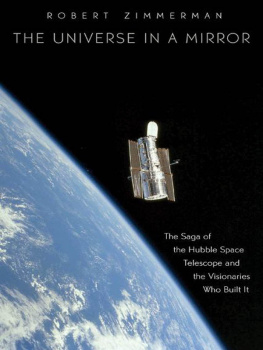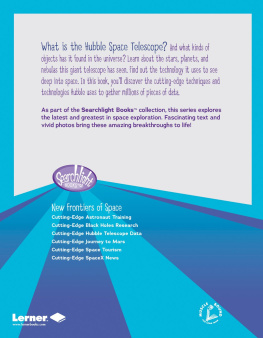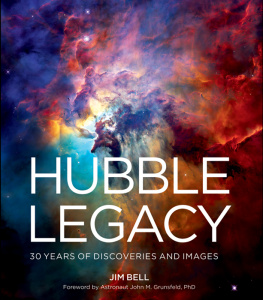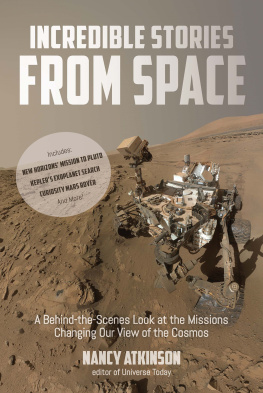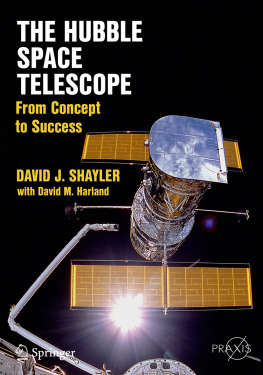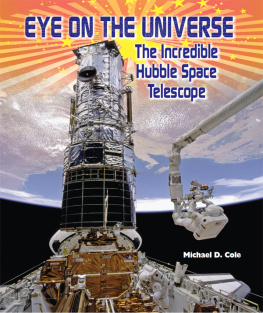
THE UNIVERSE IN A MIRROR
THE UNIVERSE IN A MIRROR
The Saga of the Hubble Telescope and the Visionaries Who Built It
WITH A NEW AFTERWORD BY THE AUTHOR
Robert Zimmerman
PRINCETON UNIVERSITY PRESS
Princeton & Oxford
Copyright 2008 by Robert Zimmerman
Requests for permission to reproduce material from this work should be sent to Permissions, Princeton University Press
Published by Princeton University Press, 41 William Street, Princeton, New Jersey 08540
In the United Kingdom: Princeton University Press, 6 Oxford Street, Woodstock, Oxfordshire OX20 1TW
press.princeton.edu
All Rights Reserved
Fourth printing, and first paperback printing, with a new afterword by the author, 2010
Library of Congress Control Number: 2007943159
ISBN: 978-0-691-13297-6 (cloth)
ISBN: 978-0-691-14635-5 (pbk.)
British Library Cataloging-in-Publication Data is available
This book has been composed in Bembo
Printed on acid-free paper.
Printed in the United States of America
10 9 8 7 6 5 4
Oh, I have slipped the surly bonds of earth,
And danced the skies on laughter-silvered wings;
Sunward Ive climbed and joined the tumbling mirth
Of sun-split cloudsand done a hundred things
You have not dreamed ofwheeled and soared and swung
High in the sunlit silence. Hoving there,
Ive chased the shouting wind along and flung
My eager craft through footless halls of air.
Up, up the long, delirious, burning blue
Ive topped the wind-swept heights with easy grace,
Where never lark, or even eagle flew;
The high, untrespassed sanctity of space,
Put out my hand, and touched the face of God.
JOHN GILLESPIE MAGEE, JR.
CONTENTS
ILLUSTRATIONS
COLOR SECTION
PREFACE
It has without question been the grandest instrument that humans have ever sent into space. For more than a decade the Hubble Space Telescope has churned out image after image, each fundamentally changing the publics perception of the universe in unexpected ways.
Conceived in the 1940s and 1950s, its gestation was long and difficult, blocked by naysayers and doubtful scientists who feared its cost.
Designed in the 1960s, its birth was long and difficult as engineers, astronomers, and bureaucrats fought over its design.
Built in the 1970s and 1980s, its childhood was at first crippled, as a fundamental error in construction left its mirror defective.
Fixed and maintained in the 1990s by high-flying astronauts who loved it as much as if not more than the scientists who used it, Hubble lifted a curtain from our view of the universe, changing it so profoundly that no human can look at the stars in the same way again. At the same time Hubble unexpectedly transformed the manner in which both astronomers and astronauts do their work.
None of this would have happened without the unceasing dedication of a host of individuals, most of whom are and will unfortunately always remain nameless. Many sacrificed years to the telescope. Some even ruined their lives and careers to get it built. A few did everything possible to get it launched, only to be left on the wayside when the telescope was finally in space and working.
This book is my attempt to tell their story, to make known a few of the men and women who conceived, designed, built, repaired, and saved Hubble over the decades. In doing so I found myself telling a story of how human beings can sometimes be shortsighted and foolish, and how they can more often rise above that foolishness to make great things happen.
I tell this story not as an astronomer, which I decidedly am not, but from the perspective of a science writer and space historian who has viewed Hubbles output with the same amazement experienced by most ordinary people. This perspective is important, since it is ordinary people who have paid for this optical space telescope and want its capability maintained. Astronomers, who often have very different reasons for building telescopes and sometimes justifiably do not consider an optical telescope their most important tool, would be well advised to listen to this perspective if they want to keep their government-funded science budgets healthy and growing.
I also tell this story with a view toward the future. In the coming decades the human race will take the first tentative steps toward establishing permanent colonies in space. When that happens, the stars above will beckon in ways that we on Earth cannot yet imagine. Living on the Moon, or in a space station, spacefarers will see the sky in all its glory, whenever they look up. It will become an essential and dominant part of their normal landscape, its splendor omnipresent and unavoidable. For pleasure, personal fulfillment, or scientific research, these spacefarers will build all kinds of telescopes, aiming them skyward to blink in wonder at the Trapezium in Orion, the Great Andromeda Galaxy in Andromeda, the Ring Nebula in Lyra, and the ever changing weather on Jupiter and Saturn.
When that happens, the human perception of the universe will undergo as fundamental a change as Galileo experienced when he first aimed a telescope at the stars. No longer will our vision of the heavens be limited to a single optical telescope orbiting the Earth. For the first time, we will have many eyes peering directly out into the unknown blackness above, and for the first time, we will truly begin to perceive the Earths place in the cosmos.
The Hubble Space Telescope gave us our first hint of what that existence will be like. We should not, therefore, forget the effort of those who made that hint possible.

This book would not have been possible without the generous help of the astronomers and engineers who built and continue to use and operate Hubble. Special thanks must be extended to Bob ODell, Sandy Faber, Jeff Hester, Ray Villard, John Wood, and everyone at the Space Telescope Science Institute as well as numerous astronomers everywhere, whose never-ending willingness to answer my endless questions always amazed me. Thank you all, again.
I must also thank the many dedicated librarians and archivists who work ceaselessly and without fanfare to keep alive the past. Specific thanks must go to Robin Dixon of the Homer Newell Library at the Goddard Space Flight Center, Marilyn Graskowiak and Mark Kahn of the National Air and Space Museum Archives, Steve Dick, Jane Odom, John Hargenrader, and Colin Fries of the NASA History Office in Washington, and James Stimpert at the Milton S. Eisenhower Library at Johns Hopkins University. Without their generous assistance I could not have written this book.
Thanks must also go to my editors, Jeff Robbins and Ingrid Gnerlich, who were both willing to say yes to the idea.
And I mustnt forget to say thank you to my wife Diane, who knows when to leave me alone when I need to work.
Finally, I must acknowledge the men and women who have been willing to risk their lives to fly into space and fix Hubble. Without their effort, none of Hubbles discoveries would have happened and the horizons of the human race would surely be more limited. It is they, as much as anyone, who make our future possible.
ROBERT ZIMMERMAN
Beltsville, Maryland
THE UNIVERSE IN A MIRROR
Foggy Vision
T he sky was dark, the air clear. It was an excellent night for astronomical photography.
On March 7, 1945, Enrique Gaviola of the Cordoba Observatory of Cordoba, Argentina, carefully positioned the observatorys 61-inch telescope for an evening of research. Painstakingly, methodically, Gaviola aimed the telescope at one of the more spectacular spots in the southern sky, the Keyhole Nebula in the constellation Carina.
Next page
